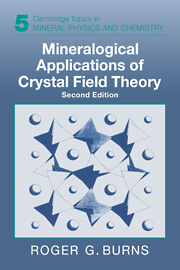Book contents
- Frontmatter
- Contents
- Preface to the first edition
- Preface to the second edition
- 1 Introduction
- 2 Outline of crystal field theory
- 3 Energy level diagrams and crystal field spectra of transition metal ions
- 4 Measurements of absorption spectra of minerals
- 5 Crystal field spectra of transition metal ions in minerals
- 6 Crystal chemistry of transition metal-bearing minerals
- 7 Thermodynamic properties influenced by crystal field energies
- 8 Trace element geochemistry: distribution of transition metals in the Earth's crust
- 9 Mantle geochemistry of the transition elements: optical spectra at elevated temperatures and pressures
- 10 Remote-sensing compositions of planetary surfaces: applications of reflectance spectra
- 11 Covalent bonding of the transition elements
- Appendices
- References
- Subject index
2 - Outline of crystal field theory
Published online by Cambridge University Press: 23 November 2009
- Frontmatter
- Contents
- Preface to the first edition
- Preface to the second edition
- 1 Introduction
- 2 Outline of crystal field theory
- 3 Energy level diagrams and crystal field spectra of transition metal ions
- 4 Measurements of absorption spectra of minerals
- 5 Crystal field spectra of transition metal ions in minerals
- 6 Crystal chemistry of transition metal-bearing minerals
- 7 Thermodynamic properties influenced by crystal field energies
- 8 Trace element geochemistry: distribution of transition metals in the Earth's crust
- 9 Mantle geochemistry of the transition elements: optical spectra at elevated temperatures and pressures
- 10 Remote-sensing compositions of planetary surfaces: applications of reflectance spectra
- 11 Covalent bonding of the transition elements
- Appendices
- References
- Subject index
Summary
Crystal field theory gives a survey of the effects of electric fields of definite symmetries on an atom in a crystal structure.
– – A direct physical confirmation should be obtainable by analysis of the spectra of crystals.
H. A. Bethe, Annalen der Physik, 3, 206 (1929)Introduction
Crystal field theory describes the origins and consequences of interactions of the surroundings on the orbital energy levels of a transition metal ion. These interactions are electrostatic fields originating from the negatively charged anions or dipolar groups, which are collectively termed ligands and are treated as point negative charges situated on a lattice about the transition metal ion. This is a gross simplification, of course, because sizes of anions or ligands such as O2−, OH−, H2O, SO42−, etc., are much larger than corresponding ionic radii of cations (Appendix 3). Two effects of the crystalline field are the symmetry and the intensity of the electrostatic field produced by the ligands. The changes induced on the central transition metal ion depend on the type, positions and symmetry of the surrounding ligands.
Orbitals
The position and energy of each electron surrounding the nucleus of an atom are described by a wave function, which represents a solution to the Schrödinger wave equation. These wave functions express the spatial distribution of electron density about the nucleus, and are thus related to the probability of finding the electron at a particular point at an instant of time.
- Type
- Chapter
- Information
- Mineralogical Applications of Crystal Field Theory , pp. 7 - 43Publisher: Cambridge University PressPrint publication year: 1993
- 3
- Cited by



